A New Beginning – Review
by Adam
|
 A few months ago, Iain provided us with an advanced look at Daedalic Entertainment’s stunningly beautiful new graphic adventure, A New Beginning. In short, he told us that this was a game that had to be ‘played by anyone with eyes’ and few adventure fans are likely to dispute that, given Daedalic’s success with Edna and Harvey earlier this year. When the review copy turned up at our offices, I quickly moved to stab out Iain’s eyes, making his pronouncement entirely redundant for himself and allowing the privilege to review A New Beginning to pass on to me. Mission accomplished, I was finally free to leap into another of Daedalic’s masterfully handcrafted point ‘n’ click adventures to see for myself just how far good looks can get you.
A few months ago, Iain provided us with an advanced look at Daedalic Entertainment’s stunningly beautiful new graphic adventure, A New Beginning. In short, he told us that this was a game that had to be ‘played by anyone with eyes’ and few adventure fans are likely to dispute that, given Daedalic’s success with Edna and Harvey earlier this year. When the review copy turned up at our offices, I quickly moved to stab out Iain’s eyes, making his pronouncement entirely redundant for himself and allowing the privilege to review A New Beginning to pass on to me. Mission accomplished, I was finally free to leap into another of Daedalic’s masterfully handcrafted point ‘n’ click adventures to see for myself just how far good looks can get you.
A New Beginning drops you into the retired life of Eco-Scientist Bent Svensson in early 1980s Norway. Bent lives alone in a small out of the way cabin, nestled in the quiet foothills of the Fjords, having dedicated his entire life to his work, losing his family in the process because he just never knew when to quit. He suffers from stress problems and is currently seeing a psychiatrist who is battling against Bent’s ingrained belief that he and he alone must somehow save the world.
It’s an incredibly mundane beginning, or at least it would be were it not for the game’s contrastingly dramatic introduction, set 500 years in the future where environmental instability has ravaged the Earth. The Phoenix Plan is put into action: an attempt to send the last remaining survivors back through Earth’s history to identify the planet’s turning point and prevent global warming from causing the catastrophes witnessed in their own lifetime. It’s risky and, even if it were successful, due to the fragile nature of time travel the future survivors are prone to wipe themselves clean out of existence, but things really are that bad and Daedalic illustrate this, literally, with a stunning comic book style prologue before we first meet Bent.
Returning to Bent, the game’s prologue continues with a brief introduction to the controls and a quick orientation on what is to be expected of you. Being a point ‘n’ click game, the majority of control is handled through pointing with the mouse cursor and left clicking to interact with the scenery. Holding left click over any ‘clickable’ object will open an interactive wheel similar to that found in the Mass Effect games, offering all object specific interactions currently available to you, beginning with ‘Look’. Right clicking opens up the inventory system across the bottom of the screen, offering you the same interactions as with the vista before you. Movement is entirely restricted to left clicking on open ground and panning the camera around as Bent nears the edge of the screen, should the location offer any extra exploration possibilities, or simply highlighting exits in order to flash on to the next scene.
Having relayed all of this through its optional tutorial, the game gently eases you into the hassles of retirement for Bent, having you cobble together a hatchet fix for a broken engine belt from items scattered throughout the initial few scenes. During the course of these activities, Bent reflects upon the discarded remnants of his former life, conveying his regrets and the decisions which led him to his self imposed exile, giving the gamer plenty of background with which they can begin to weave a nice, comfy blanket to wrap themselves up in. Partway through the task of repairing the engine belt, a helicopter lands on the hills behind Bent’s Cabin, entirely spoiling his solitary existence and introducing A New Beginning’s second protagonist, Fay.
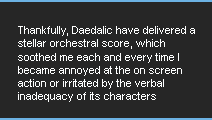 It’s here that you learn that Bent couldn’t be further from your typical hero, as he all but ignores Fay’s declaration of being ‘from the future’ and insists on continuing to fix his engine, completely unresponsive to the threat of global destruction. Having conceded that her presence can at least be of benefit to him and asking for her assistance in completing his repairs, Fay collapses into a coughing fit, re-lighting that fire within Bent to start helping people once again.
It’s here that you learn that Bent couldn’t be further from your typical hero, as he all but ignores Fay’s declaration of being ‘from the future’ and insists on continuing to fix his engine, completely unresponsive to the threat of global destruction. Having conceded that her presence can at least be of benefit to him and asking for her assistance in completing his repairs, Fay collapses into a coughing fit, re-lighting that fire within Bent to start helping people once again.
Once recovered, Fay tells Bent that she is a Time Pilot from the 26th century, sent back to encourage him to continue his research into Algae as a sustainable fuel, the most commonly used source of energy in mankind’s future. Historically, Bent gave up that research, only for the world’s top scientists to return to it once the energy crisis hit melting point many years after Bent’s death, birthing the Svensson Generator, but far too late to prevent the dramatically advanced global climate change. Fay’s mission is to encourage Bent to return to his work and make sure the world changes for the better while it still can… only to be met with grunts, disbelief and apathy.
 After this exchange, the game begins properly, seeing gameplay switch to controlling Fay as she narrates her side of the story and what has led her to Bent specifically. A narrative jump to Fay’s first venture into the past takes her to 2050 San Francisco where the world is already shown to have suffered from a lack of clean, renewable living. The city is mostly underwater, devoid of life and littered with destruction. The team’s hope was that 2050 would be as far back as they would need to jump, only to then discover that it wasn’t far enough and so they begin an investigation to decide where and when their last remaining jump should be to, given that power is incredibly limited and they have but one final shot.
After this exchange, the game begins properly, seeing gameplay switch to controlling Fay as she narrates her side of the story and what has led her to Bent specifically. A narrative jump to Fay’s first venture into the past takes her to 2050 San Francisco where the world is already shown to have suffered from a lack of clean, renewable living. The city is mostly underwater, devoid of life and littered with destruction. The team’s hope was that 2050 would be as far back as they would need to jump, only to then discover that it wasn’t far enough and so they begin an investigation to decide where and when their last remaining jump should be to, given that power is incredibly limited and they have but one final shot.
It’s a fantastic use of narrative, telling the story from Fay’s perspective from 2500 to 2050 and then to the events preceding her first meeting with Bent, all the while remaining relative in time to Bent’s story. It’s not a new concept by any standard but it’s made to work perfectly, convincing you that the events you are playing are unfolding in real time, with an occasional interruption from Bent to remind you that the two characters are still sat in his kitchen in Norway. It’s only in the game’s fifth chapter that the story begins to progress beyond the practice of this storytelling technique, happily keeping the exposition slow while quietly setting you up for A New Beginning’s more intense final few chapters, ensuring that you are as passionate about saving the world as Fay is, cleverly tracked by Bent’s growing desire to similarly ensure a safer future for all.
Fay’s adventures are joined, for the most part, by the other members of her team and a journalist/helicopter pilot who is, quite literally, landed with Fay when she finally reaches the 1980s. Bent is similarly joined by his former team of scientists who have continued to work under his son, Duve, in Bent’s absence. It makes for a good sized cast, with Bent’s team entering at just the right point in the story, following the fairly desolate opening chapters of the game where interactions with other characters are kept to just a handful of names. A few additional characters pop up in the later stages, none of whom ever appear as throwaway stopgaps to help bridge the narrative or to just tie in a puzzle, and it altogether feels like a dutifully crafted, ecologically driven mystery story, without ever bowing to popular theories or attempting to press a political agenda.
 |
 |
 |
 |
 |
 |
The strength of the plot, however, is almost outweighed by the incredibly bad voice acting. At times it feels as though some of those responsible for voicing the characters have even gone to special lengths to ensure that the game is fit only to be seen and not heard, delivering emotionless dialogue from what is an otherwise well written script. For a long portion of the game I had myself convinced that the actor responsible for voicing Bent was the same actor who voiced the Agency Director in Crackdown, as though he were still playing the part of the Agency Director and that no one had had the heart to tell him he was actually working on something else now. Thankfully for Michael McConnohie’s reputation, it isn’t him and the realisation of this had me longing for him to take the voice actor’s place. Fay is probably guilty of worse, sadly, despite being the most endearing videogame character I’ve encountered since Jade in Beyond Good and Evil. Her entire story is fantastic and you can truly sympathise with her throughout, until she opens her mouth that is and, suddenly, you’re reminded of just how wrong the casting department got this one.
Dialogue is flat and bland, turning some situations into farce and pulling you clean out of the experience entirely whenever any emotive expression is attempted. With on screen subtitles present by default, you soon find yourself click-skipping through dialogue, opting to read the text instead of enduring the verbal torture. Sadly, this isn’t always the best option as the text will sometimes slip into the game’s native German and you’ll find yourself forced to sit through the, sadly, genre standard level of voice acting once more. Given that I was never offered the option of installing the game in any language other than English, I found this to be an especially strange bug to encounter in what is otherwise a technically proficient game.
It also appeared to me that sections of the game involving heavy narrative and exposition had been retrofitted with gameplay elements to keep the player engaged, done so without much thought or care given to the separation of audio tracks, which were presumably laid together originally as one continuous piece. Conversing with other characters, selecting topics to discuss and responses delivered during gameplay are generally fine, but interactive elements of the comic book styled cut-scenes were clearly never designed to support the same interaction, often cutting out a few seconds too late as the next response begins to play before you select it, highlighting what little influence you have in the way the scene will progress. I also found several instances where the on screen text differed from the voice actor’s script – who, it would appear, has decided to ad-lib some of the poorer translations with no effort made to account for it.
On another technical note, I was disappointed to discover that the game is restricted entirely to a 4:3 ratio, with no widescreen options available, meaning that anyone with a 16:9/16:10 screen will find thick black bars along both sides. You get used to it in no time, given the visual luxuries offered by what is left, but it still disappointed me to think that in 2011, no consideration had been given to the more widespread use of wider desktop monitors and laptop screens. I did have a tinker around with some .cfg files (which I’m sure Daedalic would wish remain untouched), but this understandably distorts the visuals and ultimately downgrades the experience. It is regrettable but it is something the player will have to live with.
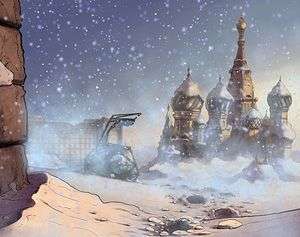 From a gameplay perspective, A New Beginning is a bit of a Spanish minefield – a casual walk for the most part, but will eventually stop you dead in an instant. Each of the game’s eight chapters only allows access to a few different environments, never overwhelming you and keeping the player directed and focused on the tasks at hand. With everything being carefully hand drawn, it’s often difficult to tell what you’re able to interact with, resulting in a pixel hunt with the cursor, just waiting for it to illuminate blue so that you’re able to start experimenting with possible interactions once again. For the most part, every puzzle is easy to identify and solve, although occasionally you will find yourself in the sort of scenario where despite knowing what it is you need to do, you just can’t seem to do it.
From a gameplay perspective, A New Beginning is a bit of a Spanish minefield – a casual walk for the most part, but will eventually stop you dead in an instant. Each of the game’s eight chapters only allows access to a few different environments, never overwhelming you and keeping the player directed and focused on the tasks at hand. With everything being carefully hand drawn, it’s often difficult to tell what you’re able to interact with, resulting in a pixel hunt with the cursor, just waiting for it to illuminate blue so that you’re able to start experimenting with possible interactions once again. For the most part, every puzzle is easy to identify and solve, although occasionally you will find yourself in the sort of scenario where despite knowing what it is you need to do, you just can’t seem to do it.
This is of course entirely bypassed once you discover that the game possesses a ‘reveal all’ button. Having sat through the tutorial, I had operated under the assumption that all of the information I needed to know had already been related to me, and that I was, quite simply, on my own from here. Discovering that the Spacebar was standing by, ready to light the screen up like a Christmas tree was both a welcome and unwelcome discovery. I was glad to finally discover that the game had such a feature, but thoroughly disappointed never to have been told that in the first place. On reflection, is fair to point out that I only discovered this after I had completed the game and that my experience would definitely have been a less stressful one had I known this. I’ll let you cast judgement on who failed whom in this instance.
These puzzle sections will punish you brutally with no tips given, no interruptions from Bent or Fay (which the narrative style is perfectly positioned for), instead providing only a frustrating reminder that this doesn’t go there or that you can’t do that. You can literally have an entire chapter’s worth of puzzles worked and mapped in your head, only for one crucial detail – which you can’t seem to spot – to stand defiantly in your way and moon you from behind nine inch thick Perspex. Once you eventually discover that missing detail, you’ll not smack your head and declare yourself a fool for being so naive, instead you’re more likely to save the game, close it down and consider going outside for a smoke, or to a shop to buy cigarettes and then to take up smoking. Just when you think you’ve got it all under control, the game will throw in one of its even more challenging puzzles to tax you with, dropping the need to move about the environment and focusing purely on one separate, standalone challenge.
 |
 |
 |
 |
 |
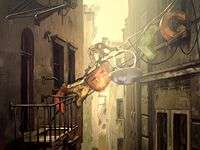 |
As with some of the environmental puzzles, you can have these easily figured out in your head but, in practice, you just can’t find a place to begin from, or even make the supposed logic apply. The very first puzzle you’re given is the construction of a radio antenna, all packaged up in a tight and tidy briefcase. You’re not given any plans to construct it with (Ikea did not survive the ecological apocalypse I would assume) and common sense will only get you so far. Eventually, you’ll start to resort to anything, only to then spot the answer on the ‘Click to Close’ lid of the case you pulled all of the parts from. It’s not easy to make out, but you can see a sketch of what the assembled antenna should look like, and it’s easy to figure out what goes where from that. Within seconds, I had most of the rest of the antenna assembled, leaving only a few parts to tack on (maybe Ikea really does survive then). I knew where these parts had to go but the game wouldn’t let me attach them. Only then did I discover that I’d missed a tiny switch which, after flicking, allowed me to make to two further adjustments… only to then have the entire process grind to a halt once again. I was infuriated that the game would not let me complete the puzzle; it wasn’t an issue on my part of not being able to come up with the solution, but on the part of the game’s poor design that it simply wasn’t happy to acknowledge that I actually knew what I was doing. I conceded and hit the big red ‘Skip’ button that appears during these particular puzzles, hoping that I could draw a line under it and move on.
The game wasn’t done pissing me off, unfortunately. After clicking to skip, I was expecting to see the remaining puzzle completed and visually explain to me where I was going wrong. Of course, the developers decided that the best thing to do in this situation was to ‘flash-build’ the rest of the puzzle in a ‘blink and you’ll miss it’ kind of way and then have the game instantly move on. I genuinely was made to feel like an absolute idiot. The game had all but smacked me square in the face as hard as humanly possible, taken the keys to my car, driven to my beloved girlfriend’s house and advised her of my inadequacy in antenna construction during future environmental apocalypses, encouraging her to leave me at the first possible convenience. Sure, it doesn’t matter in the grand scheme of things, as I was now able to continue on with the game, but it still hurt to not know where I was going wrong. I gather that this is pretty much a staple for the modern day point and click but for returning old school minds and new born fans of the genre such as myself, it’s a taunting reminder of our inadequacy that we could perhaps do without. In case my girlfriend is reading this, please don’t also expect me defuse a bomb with multiple fuse switches, navigate three water tanks of varying water levels or manage wattage restrictions with regards to jump starting a turbine. Also, I wouldn’t buy any furniture from Ikea, I doubt the warranty will hold up.
Thankfully, Daedalic have delivered a stellar orchestral score, which soothed me each and every time I became annoyed at the on screen action or irritated by the verbal inadequacy of its characters. The music in A New Beginning is every bit as wonderful as the art style and builds on the aesthetics of the game’s varied locations. There’s little repetition amongst the tracks and you never once find yourself tiring of any one piece. Each melody is appropriate to the mood and tempo of the chapters and without such diligence, I probably would have opted for the early nineties approach to point ‘n’ clicks and just survived with subtitles for the whole game.
Another saving grace is A New Beginning’s fine sense of humour. While it can get a little frustrating at times as you track backwards and forwards from screen to screen, trying anything on everything, only to be met with the same five variants on a theme of ‘no’, occasionally they drop in something that really makes you smile. During sections recounted by Fay, she’ll occasionally retort ‘I could try to do that, but of course I didn’t do that, that would be stupid’ or be interrupted by Bent, only to start a similar discussion between the two that will make you smile as they discuss the merits of a solution you thought was entirely acceptable. I also encountered a ‘Chef’ during the game’s fifth chapter who left me almost distraught when I realised I wasn’t going to get to spend more time with him. He was the one character I felt had really been nailed; completely insane and brilliantly funny, who I’ll say nothing more of for now, but look for his return in the Great GamingLives Annual Awards as my nominee for Best Minor Character. I also happened to spot someone partway through chapter three who brought yet another smile to my face; someone who would be little more than a detail in the setting for many, but a lovely nod for fans of Daedalic’s previous title, which brightens A New Beginning’s generally serious tone.
- • Beautiful art direction
• A superb orchestral score
• Gripping, detailed story
• Could easily have become a lecture in environmental sciences but remains light and engaging at all times
- • Appalling voice acting
- unless you’re a member of the secret Spacebar club that is!
• Infuriating difficulty spikes
• Suffers from poor audio engineering and hasn’t weathered translation well
• No auto-saves, so don’t rage quit too hard
• No widescreen in a game that is practically begging for it
• Relies less on logic and more on pixel hunting and trial and error
Print yourself out two copies of this review and get yourself a thick black pen. With the first copy, strike out everything good I have to say about this game and with the second copy, strike out everything bad I have to say about this game. Your second copy will feature less text and your first copy will definitely feature a lot less pen. Now go buy yourself a lighter and set fire to that first copy.
Every bad thing I have to say about A New Beginning is instantly trumped by everything good I have to say. It is not a great game in far too many respects and, for some, those failings will cost it its place in the graphical adventure/point ‘n’ click hall of fame. Anyone who is able to overlook its flaws really is setting themselves up for something magical. A New Beginning is an adventure you won’t want to pass up on, taking you on a journey through a beautifully crafted story that you’ll care more about than the game would have you believe. Each and every chapter is entirely compelling and the game manages to fly in the face of its fellow point and click kin by having a well thought out, challenging ending.
Bent Svennson and Fay may well not be the greatest world saving duo I’ve had the pleasure of saving the planet with, but I fell in love with them all the same. It probably wasn’t by design that Bent became a caricature of the straight guy or that Fay would come across as an overbearing member of an amateur dramatics society, but the lengths the narration goes to in order to ensure that you understand their motives and thought processes, administered in just the right doses, makes you sad when it’s all over and leaves you with the realisation that, once the credits have rolled, the three of you won’t be hanging out anymore. So, buy A New Beginning, forget what it is you’re told that you have to find in a great game, and just this once play yourself a truly enjoyable title, regardless of its flaws. Just don’t throw away that lighter, you’re going to need it for that smoking habit you’re about to develop.
Last five articles by Adam
- Party Pooper
- Battlefield 3 - Review
- Red Orchestra 2: Heroes of Stalingrad - Review
- Burnout CRASH! - Review
- Dead Island - Review















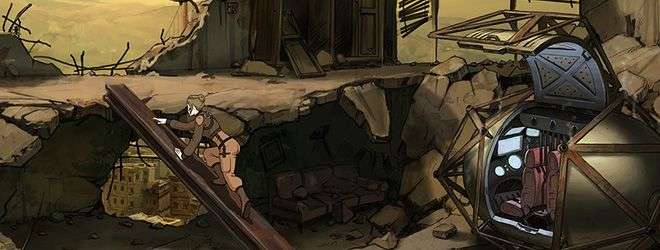


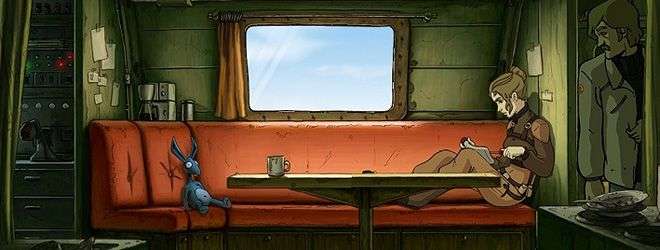





Adam, you’ve trumped yourself again; this review is hilarious, insightful and brilliantly written. A New Beginning had my attention from the start with its art style, genre and premise (I’m a sucker for time travel), and you and Iain have really cemented my desire to one day play it. Great job, and I hope this game sells well.
Gee Fanx Ed
This really is a pearl of a PnC. The story is outstanding and the adventure is superb. Just wish I knew about that Spacebar…
This looks gorgeous. Thing is, if that same beautiful artwork results in pixel hunting tedium then I’d get fed up with it very quickly indeed. Other point and clicks have been hand drawn and painted without that being an issue, so it seems a little bit of an own goal.
Bad voice acting is my kryptonite too. Shame. I really liked the look of it when Pix first talked about it, but my interest has cooled since and I’m not sure I’d go for it.
Might look up the soundtrack though, after hearing bits of it on Youtube trailers and clips of the game, if they release a special edition with the soundtrack similar to Machinarium and Men of War I’ll probably wind up buying it for that at some point in the future.
Good write up Ad.
Thanks Sam,
Don’t let me mislead you, it can be a pixel hunt but the game has accounted for that by providing a ‘reveal all’ button should you decide to give up.
It’s an odd call to make, either we have a seamless, beautifully drawn world that can stunt the flow of gameplay a little or we have a world with pre-rendered backgrounds and dropped on interactions which break the immersion. Tough one.
I’m not convinced you need to choose between the two though. Machinarium and Edna & Harvey were both handdrawn without that impeding the gameplay any.
The first image is stunning and enough alone to make me want to look into it more, lovely art style on it.
I feel that I should interject with regards to ‘pixel hunting’. All point and click adventures, by their very nature, require you to explore each scene provided in search of clues, objects, and things with which to intereact. It is the core gameplay mechanic. In the interests of realism and not pandering, these things aren’t going to be marked with a huge glowing outline, you are expected to find them. Every P&C worth their damn has had a reveal all button for years anyway for reasons of ease, time, and lessening frustration.
I guess I just don’t understand why this perfectly natural gameplay mechanic is being made an issue, when to be honest, it is no different that every other point and click title out there. You find stuff one way or the other – it won’t leap out unless you want it to. There is only pixel hunting if you allow there to be, and therefore it is only an issue if you don’t utilise the tools on offer.